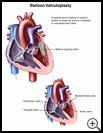
Balloon Heart Valve Surgery (Balloon Valvuloplasty)
________________________________________________________________________
KEY POINTS
- Balloon heart valve surgery uses a balloon to stretch a heart valve or to break up scars in the valve. Heart valves direct the flow of blood through the chambers of the heart and to the rest of the body.
- You may need this procedure if you have a valve that cannot open all the way. This procedure may be done instead of surgery to replace the valve.
- Ask your provider how long it will take to recover and how to take care of yourself at home.
________________________________________________________________________
What is balloon heart valve surgery?
Balloon heart valve surgery (valvuloplasty) is a procedure for opening a blocked or narrowed heart valve. Heart valves direct the flow of blood through the chambers of the heart and to the rest of the body. This procedure uses a balloon to stretch the valve or to break up scars in the valve.
When is it used?
You may need this procedure if you have a valve that cannot open all the way. The valve may block the flow of blood to the lungs, to other chambers of the heart, or to the body.
This procedure may be done instead of surgery to replace the valve, but it may not fix the valve completely. If you are very sick, it may be done to help you until you are healthy enough to have valve replacement surgery.
How do I prepare for this procedure?
- Make plans for your care and recovery after you have the procedure. Find someone to give you a ride home when it’s time to leave the hospital. Allow for time to rest and try to find other people to help with your day-to-day tasks while you recover.
- You may or may not need to take your regular medicines the day of the procedure. Tell your healthcare provider about all medicines and supplements that you take. Some products may increase your risk of side effects. Ask your healthcare provider if you need to avoid taking any medicine or supplements before the procedure.
- Tell your healthcare provider if you have any food, medicine, or other allergies such as latex.
- Your healthcare provider will tell you when to stop eating and drinking before the procedure. This helps to keep you from vomiting during the procedure.
- Follow your provider's instructions about not smoking before and after the procedure. Smokers may have more breathing problems during the procedure and heal more slowly. It’s best to quit 6 to 8 weeks before surgery.
- Follow any other instructions your healthcare provider gives you.
- Ask any questions you have before the procedure. You should understand what your healthcare provider is going to do. You have the right to make decisions about your healthcare and to give permission for any tests or procedures.
What happens during the procedure?
You will be given medicine to help you relax, but you will be awake during the procedure. You will be given a local anesthetic to numb the area where the catheter will be inserted.
Your healthcare provider will put a small tube called a catheter through your skin and into a blood vessel in your groin. The balloon will be passed through the blood vessel and into your heart valve. Your provider will inflate the balloon to make the valve opening larger. This may be repeated several times until the valve opening is the right size.
At the end of the procedure, your healthcare provider will remove the catheter and wire and put pressure on the area where the catheter was inserted (the puncture site) to control any bleeding.
What happens after the procedure?
You will be in the hospital for several days.
Ask your healthcare provider:
- How long it will take to recover
- If there are activities you should avoid and when you can return to your normal activities
- How to take care of yourself at home
- What symptoms or problems you should watch for and what to do if you have them
Make sure you know when you should come back for a checkup. Keep all appointments for provider visits or tests.
What are the risks of this procedure?
Every procedure or treatment has risks. Some possible risks of this procedure include:
- You may have problems with anesthesia.
- You may have infection, bleeding, or blood clots.
- Other parts of your body may be injured during the procedure.
- The test can cause irregular heart rhythms, which might need treatment.
- The valve may tear when the balloon is inflated. This may require valve replacement surgery.
- When the catheter is inserted, debris on the wall of the artery may become dislodged and pass down your artery, causing a stroke or other blockage. You may need surgery if this happens.
Ask your healthcare provider how these risks apply to you. Be sure to discuss any other questions or concerns that you may have.

